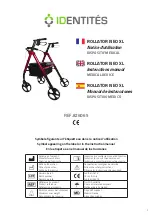Summary of Contents for Spectra XTR
Page 1: ...Invacare Spectra XTR Electric wheelchair Instruction manual Yes You Can ...
Page 43: ...43 Release wing screw 2 Remove the armrest from the mounting ...
Page 72: ...72 Loosen the screw 1 using the Allen key Set the desired angle Re tighten the screw ...
Page 137: ...137 Pull the front battery case backwards using the belt and pull it out using the handles ...
Page 140: ...140 Fold the seat upwards Pull the remote cable plug out of the electronics system ...
Page 152: ...152 Order No of this Manual 1528224 DOC Release Date 23 06 09 English ...
















































